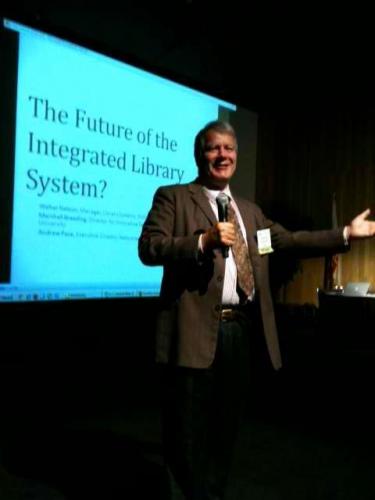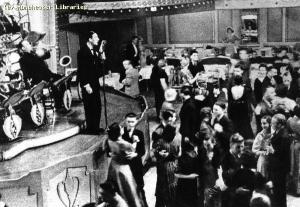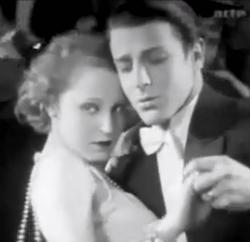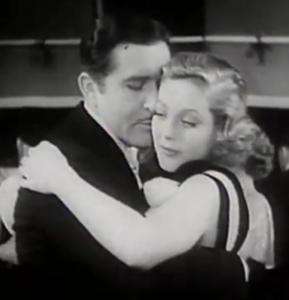Social Dancing and the Art of Conversation
 "Part of the joy of dancing is conversation. Trouble is, some men can't talk and dance at the same time." - Ginger Rogers
"Part of the joy of dancing is conversation. Trouble is, some men can't talk and dance at the same time." - Ginger Rogers
A very brief observation:
There's a key element of social dance, as it is actually practiced, that really gets short shrift. Dance manuals ignore it and you're not likely to hear about it in a dance class.
I recently had one of those "aha" moments in looking at photos from a Jazz Age dance event. Several of them were of me and my partner, on dance "automatic pilot", having a pleasant conversation. That "aha" was that conversation, in real social dance, is not a digression. It isn't something you do that detracts from the business at hand: the serious business of dancing. It is intrinsic to the "social" part of social dancing. It is every bit as legitimate a use of your dance floor time as a step routine or dance figure.
So, whether your partner is a lover, a friend, an acquaintance or someone you just met, if you have something to say, say it. If you don't, then just dance. The time is your own to do with as you will. There really is nowhere else that is quite as public, and yet as intimate and private as a dance floor. What ever you have to say, be it trivial or profound, there's probably no better time for it. You won't be overheard.
I don't really need to exhort people to do this. I'm sure you all do it anyway. Banter (witty or otherwise), declarations of love, profound or shallow observations, jokes, dinner plans, relationship talk, gossip, the weather, it's all fair game for that most private of public conversations; and it always has been.
Balboa, Shag & Foxtrot in Los Angeles in 1936
From the film "Marihuana", which used an anti-drug message as a cover for some pretty racy stuff. The dance scenes clipped together here show bits of Balboa, Shag and even a bit of Fox Trot right at the end.
How To Not Give A Tedious, Terrible PowerPoint Presentation
 I realize that the title of this piece promises more than it may, in fact, deliver. Reading this will not warranty you against giving a bad presentation. It might help though.
I realize that the title of this piece promises more than it may, in fact, deliver. Reading this will not warranty you against giving a bad presentation. It might help though.
Here are a few things I have learned over the years, done by me and by other presenters - some good, some not so good, and some disastrous. However, each person is different, and different things work better for some folks than others. Your mileage may vary.
This is about the substance and style of your presentation. For issues of technology, go here.
Relax. It's not that bad
There are a lot of "rules" here, but many good presentations and good presenters break one or more of them. If you know your topic, and you care about that topic, and you can convey that enthusiasm to your audience, you'll probably do fine, even if you break a rule or two.
Make a Point
You can have one or multiple points to make, but try to present some insights about your topic that your audience may not have considered. Do not just say "Here is a thing", but try to say "And here is why that thing is interesting, and here's what that thing says about a broader issue and relates to other things"
Be Passionate
Care about your topic as much as it is possible to care about your topic. Your enthusiasm for what you are saying is the key to engaging your audience. This works best if you are presenting on a topic that is near and dear to you, when the passion should flow naturally. If you are presenting the next fiscal year spending projections, do your best to convey some enthusiasm, or at least your sense of why it's important, to your audience - but don't be phony or forced about it, as that will always backfire.
The French "Java" Waltz Variation
A collection of clips from European films of the '20s & '30s showing the French Java (a bouncy waltz variation) being danced. Music is "Ca Gaze" by the Baguette Quartette.
.
Where People Danced in the Jazz Age
In getting a sense of the dances of the Jazz Age, it's helpful to also get a feeling for where people were dancing.
In short, almost everyone danced and they danced almost everywhere. Many public events had provisions for dancing, and there were frequent private dances of all descriptions. They covered the whole gamut of social class and ethnicity, and were as formal or informal as was the habit within that group: though nearly everyone, rich or poor, black, white or brown, would at least wear dresses, coats and ties to go out in public and dance, even if they weren't part of a socioeconomic group that could afford "evening dress".
 Colleges and high schools had frequent dances. Clubs (especially "country clubs") and other private organizations like fraternal organizations (Masons, Elks, Grange, VFW, Woman's Clubs etc.) threw frequent dances for their constituencies. Hosting a dance seemed to be a prime way for a group to affirm its identity.
Colleges and high schools had frequent dances. Clubs (especially "country clubs") and other private organizations like fraternal organizations (Masons, Elks, Grange, VFW, Woman's Clubs etc.) threw frequent dances for their constituencies. Hosting a dance seemed to be a prime way for a group to affirm its identity.
I recently reviewed the old company newsletters of my corporate employer, and was struck by how many formal dinner dances they threw back in the '50s and early '60s for their employees and their families, because when men and women got together, they danced.
Private functions of all types (dinner parties, charity galas, weddings, picnics) frequently included planned or spontaneous dancing, since dancing was enthusiastically pursued in every social class and, with the exception of those who had a religious scruple against it, every element of society. Music could be live (professional or performed by the guests) or provided by a gramophone or radio.
As to the public dance scene: the following categorization of public dance venues is based upon a list in "The Taxi Dance Hall: A Sociological Study in Commercialized Recreation & City Life" by Paul Goalby Cressey, 1932. He is describing the dance scene in Chicago in the early '30s, just before the repeal of Prohibition.
My Jazz Age Journey: A Few Thougths on Historical Dance
 The process of recreating the ballroom dances of the Jazz Age has been an eye-opening journey, and has led me to a new (for me) way of dancing that I have come to love. It has also made me question my long-standing assumptions about what it means to dance.
The process of recreating the ballroom dances of the Jazz Age has been an eye-opening journey, and has led me to a new (for me) way of dancing that I have come to love. It has also made me question my long-standing assumptions about what it means to dance.
Background
A couple of years ago I came to the realization that the internet is now brimming with film footage from the Jazz Age showing people dancing. Just a few years ago, original dance footage was a big deal to get, requiring much time, effort and expense to obtain a few brief snippets of footage. Now, almost overnight, we are awash in it. The Swing community sussed to this fact some time ago, but the vintage ballroom folks (myself included) were pretty much oblivious.
When I do a thing, I tend to overdo it, and this has been no exception. I tracked down hundreds of clips from old movies, and used them to construct a picture of the of the dances of the 1920s - 40s; a period I am very interested in as I frequently attend, and occasionally organize "vintage dance" events set in that era. However, I had only the sketchiest of ideas of what was actually done at the time, and as I started to look at the footage, I realized that many of those ideas were not only sketchy but entirely wrong. Much of what I had been taught or assumed about the dance of the time had been filtered through the prism of the modern forms of those dances. The Foxtrot, the Tango, the Waltz are all danced a certain way today, and the natural reflex is to say "Oh, I know the Foxtrot and the Foxtrot I know must be what was danced".
This is, of course, wrong because dances evolve over time; but it put me in a rather unique position. To learn these dances, I could not just take a class. While much of what I might learn in a regular ballroom dance class could be applicable; most of the modern orthodoxy and technique was clearly, from looking at the films, not applicable. I was going to have to rely on films and, to a lesser extent, books to be my teachers; along with the essential help of my wife and the many other women who have been my partners and collaborators in making sense of all this.
9. Dancing in Weimar Berlin
 Germany during the era of the Weimar Republic (1919-1933) was a place of political conflict and economic chaos; as well as a nexus of cultural ferment, a flowering of invention and creativity, and a rejection of pre-Great War social norms and cultural conventions. It was also notorious for the vitality of its decadent night life, awash in sex and booze and jazz music: jazz music provided by hot German bands with their own distinctive national sound.
Germany during the era of the Weimar Republic (1919-1933) was a place of political conflict and economic chaos; as well as a nexus of cultural ferment, a flowering of invention and creativity, and a rejection of pre-Great War social norms and cultural conventions. It was also notorious for the vitality of its decadent night life, awash in sex and booze and jazz music: jazz music provided by hot German bands with their own distinctive national sound.
The dance of fashionable Weimar Germany was indistinguishable from the dancing you would see in London or New York. In the countryside or in "folk" events, you might well see good old fashioned rotary Waltzes, as well as dances like the Polka, Ländler, Zweifacher etc.; but in the night clubs of sophisticated cities like Hamburg or Berlin, only modern dances like the Foxtrot, Tango, Passo Doble and the "modern" Waltz were welcome. Occasionally, the Charleston would make an appearance.
Foxtrotting and Why it's Cool to be a Grown-up
 It's not a stunning revelation to say that dancing has changed a lot in the last half century. We all know that, but I don't know that most of us have really thought about the ways it has changed and how it reflects the ways our world has changed.
It's not a stunning revelation to say that dancing has changed a lot in the last half century. We all know that, but I don't know that most of us have really thought about the ways it has changed and how it reflects the ways our world has changed.
"Back in the day" which for my purposes, I will encapsulate in the 50 years between 1910 and 1960, dancing played a central role in the social lives of mature adults which it has entirely lost today. Today, among adults, with a few notable exceptions, almost nobody dances. Back then, almost everyone danced.
Night clubs, hotels, ocean liners and any place where people gathered to socialize had live music and a dance floor. Municipalities, corporations, fraternal lodges and community organizations sponsored dinner dances, where people got dressed up and men and women danced together - and their "signature" dance - by far the most popular and pervasive, was the Foxtrot. The dance floor was often too small, and it was crowded, but it was crowded precisely because almost everyone danced.
Starting in the early 20th Century, there was a clear distinction between Youth Dances and Adult Dances. The kids did the Charleston which became Collegiate, which became Swing, which became Rock & Roll (a species of Swing). Adults danced the Foxtrot, Tango and Waltz (but mostly Foxtrot) and occasionally Latin dances like Rumba, Samba, Cha Cha etc.(all fall in a category now referred to as "Ballroom Dances"). There was a distinctly adult way to dance and a distinctly kid way to dance, and when kids grew up, they gave up the wild kicks, spins, leaps and flying skirts and settled into a style more appropriate to their adult lives. We often refer to "Youth Culture" and tend fix on that when defining past decades in our minds, but we tend to overlook the fact that there was once an "Adult Culture" as well, which was much more ubiquitous and influential than the fads of wild youth.

